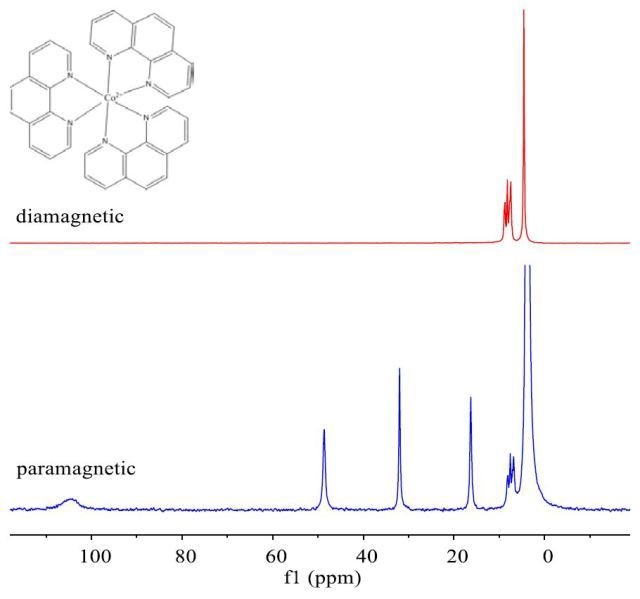The presence of paramagnetic ions in most organometallic complexes increases the proton spectra’s chemical shift range to hundreds of ppm. However, achieving such large bandwidths at high field is a challenging task.
Magritek Spinsolve Benchtop NMR Spectrometer
The Magritek Spinsolve benchtop NMR spectrometer is equipped with a special Paramagnetic protocol that allows scanning of paramagnetic samples. The acquisition bandwidth is 20kHz relative to the frequency range of 480ppm. The reduction in the relaxation time (T1) of the sample by the paramagnetic ions leads to faster scan times through shortening of the repetition time between scans to 3s.
This article presents the representative examples demonstrating the advantage of using the Paramagnetic protocol of the Magritek Spinsolve benchtop NMR spectrometer for resolution of peaks that cannot be observed in the standard 1D Proton protocol.
Representative Examples
This example shows the ability of paramagnetic ions to increase the spectral range. Here, a bis(n-2'- butylsalicylicylaldiminato)nickel(II) sample was prepared by dissolving it in CDCl3 for subsequent analysis using the 1D Proton and Paramagnetic protocols. The comparison of the NMR spectra for the two protocols is shown in Figure 1. As can be seen, the 1D Proton protocol’s bandwidth is inadequate to cover the whole spectrum of the sample. Conversely, the Paramagnetic protocol reveals all the spectral features of the sample.

Figure 1. 1H NMR spectrum ofbis(n-2'-butylsalicylicylaldiminato)nickel(II) dissolved in CDCl3 using the 1D Proton (red) and Paramagnetic (blue) protocols.
This illustration shows the reaction of coordinated ligands that uses the transformation of paramagnetic [Co(phen) 3]2+ to diamagnetic [Co(phen) 3]3+ complexes. The NMR spectra shown in Figure 2 clearly show drastic difference in the chemical shift range between the diamagnetic and paramagnetic cobalt complexes.

Figure 2. NMR spectrum of diamagnetic and paramagnetic Co(phen)3 dissolved in D2O, using the Paramagnetic protocol.( Spectra courtesy of Paul S Donelly, University of Melbourne.)
Conclusion
Collecting NMR spectra from paramagnetic samples is a challenging task. The Paramagnetic protocol of the Spinsolve benchtop NMR spectrometer resolves peaks in broad line spectra. This is not possible with standard techniques.

This information has been sourced, reviewed and adapted from materials provided by Magritek.
For more information on this source, please visit Magritek.